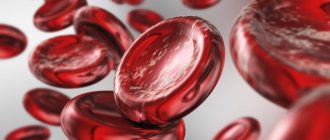Gout
Diabetes
Atherosclerosis
43711 07 April
IMPORTANT!
The information in this section cannot be used for self-diagnosis and self-treatment.
In case of pain or other exacerbation of the disease, diagnostic tests should be prescribed only by the attending physician. To make a diagnosis and properly prescribe treatment, you should contact your doctor. We remind you that independent interpretation of the results is unacceptable, the information below is for reference only
: indications for use, rules for preparing for the test, interpretation of the results and normal indicators.
Indications for prescribing the study
Uric acid is a product of the exchange of purine bases that are part of complex nucleoprotein proteins.
The precursors of uric acid are purines (guanine and xanthine - components of the nucleic acids DNA and RNA), which are formed endogenously or come from food, as well as purine nucleosides, from which adenosine triphosphate (ATP) and similar compounds are formed. Under the influence of enzymes in tissue cells, nucleic acids disintegrate.
Uric acid is synthesized mainly in the liver. In blood serum it is present in the form of sodium salt (urate) in a concentration close to saturation and is poorly soluble in water. If the threshold concentration is exceeded, sodium salts may crystallize. The higher the serum uric acid level, the higher the risk of developing a disease such as gout.
The formation of monosodium urate crystals occurs when the concentration of uric acid in the blood serum is above 420 µmol/l. In some cases, crystal formation is possible at lower levels (360 µmol/l).
Crystal deposition occurs in articular and/or periarticular tissues, kidneys and other organs in the form of tofus (lat. tofus
- porous stone). The disease most often affects the big toe, foot, ankle, knee, fingers, wrist and elbow, but can affect any joint. The deposition of monosodium urate crystals in the synovial fluid and nearby tissues triggers a cascade of immune reactions. The presence of monosodium urate crystals in the joints and surrounding tissues causes a chronic inflammatory process.
Two-thirds of uric acid is excreted by the kidneys. One third of uric acid is metabolized in the intestine by intestinal bacteria. Typically, the processes of synthesis and excretion of uric acid are balanced.
An increase in uric acid in the blood can occur for several reasons:
- with a decrease in the excretion of uric acid in the urine due to impaired renal function, a decrease in the volume of extracellular fluid, under the influence of alcohol and certain medications, fasting, etc.);
- with an increase in its production in the body:
- with excessive intake of purines from food (purines are found in large quantities in fatty meat, liver, kidneys, meat extracts, dry wine, beer, etc.);
- with increased breakdown of liver cells in chronic alcoholism, hemoblastosis, paraproteinemia, chronic hemolysis, antitumor therapy.
Eating high amounts of animal protein, being overweight, high blood pressure, alcohol, diuretics, insulin resistance, hematologic cancer, and other factors can increase uric acid levels and contribute to the development of gout.
Thus, the indications for prescribing an analysis for uric acid levels are the following diseases and conditions:
- primary gout;
- secondary gout, which occurs against the background of diseases with excessive formation of uric acid or impairing its excretion:
- acute infectious diseases (pneumonia, erysipelas, tuberculosis, etc.),
- diseases of the liver and biliary tract,
- diabetes mellitus with acidosis,
- psoriasis, eczema, urticaria,
- kidney diseases,
- acute alcohol intoxication,
- lymphoproliferative diseases, leukemia.c
What indicator is considered normal?
During puberty, the amount of uric acid begins to gradually increase and reach levels characteristic of adults.
Men have more stable values throughout life: from 210 to 420 µmol/l.
For women of reproductive age, the level decreases due to the hormone estrogen and ranges from 150 to 350 µmol/l. When reaching the age of decline of childbearing function, the concentration increases.
The limit value, the achievement of which serves as a basis for recognizing hyperuricemia, is 360 µmol/l. At this value, the likelihood of gout in men increases by four times, in women by seventeen times. A lower value does not prevent the dissolution of urate crystals and prevent their formation.
Thus, the level of uric acid in the blood is as follows:
- in children under 14 years of age – from 120 to 320 µmol/l;
- in women – from 150 to 320 µmol/l;
- in men – from 210 to 420 µmol/l;
- at the age of 65 years – up to 500 µmol/l.
The tests must be interpreted by a doctor who evaluates several indicators in combination.
What can affect the result
- The following medications can lead to an increase in uric acid in the blood serum: thiazide diuretics, anabolic steroids, nicotinic acid, epinephrine, caffeine, vitamin C, beta-blockers, furosemide, calcitriol, ethacrynic acid, cyclosporines, cisplatin, asparginase, clopidogrel, diclofenac , ibuprofen, isoniazid, ethambutol, indomethacin, piroxicam.
- A decrease in uric acid in the blood serum can be caused by taking allopurinol, amlodipine, verapamil, chlorprothixene, vinblastine, methotrexate, glucocorticoids, imuran, warfarin, levodopa, methyldopa, contrast agents, spironolactone, azathioprine estrogens.
Causes of increased uric acid in the blood
Reasons why uric acid in the blood is elevated include:
- gout;
- pathologies of the endocrine glands;
- blood diseases, including leukemia;
- a disease of hereditary nature, expressed in enzyme deficiency and increased production of uric acid in childhood (Lesch-Nyhan syndrome);
- multiple myeloma;
- cancer of the lymphatic system;
- anemia caused by vitamin B12 deficiency;
- kidney pathologies, including polycystic disease, renal failure, kidney stones;
- disproportionate growth of body parts due to hormonal imbalance;
- diabetes;
- hypoparathyroidism;
- eating disorders: abuse of alcoholic beverages, protein foods or prolonged abstinence from food;
- excess body weight, atherosclerosis;
- hypertension, ischemic heart disease,
- the use of certain drugs - diuretics, aspirin, antitumor drugs;
- complication of pregnancy with toxicosis;
- neoplasms of a malignant nature.
Knowing the cause of hyperuricemia is important for choosing treatment methods and preventing dangerous complications.
Reasons for low uric acid in the blood
The level of uric acid in the blood may be low if:
- Konovalov-Wilson disease, manifested in excessive accumulation of copper in the body and serious damage to systems and organs;
- congenital pathology of the renal tubules;
- xanthinuria;
- taking medications for gout, drugs for contrast X-rays, immunosuppressants, steroid hormones;
- lymphogranulomatosis;
- diet low in purines.
Detection of low levels is less common; a specialist should draw conclusions about pathology or a variant of the norm.
Rheumatoid factor
A blood test for rheumatoid factor is aimed at identifying specific IgM class antibodies to IgG class antibodies.
A laboratory test for rheumatoid factor is a screening test aimed at identifying autoimmune disorders. The main objective of the study for rheumatoid factor is to identify rheumatoid arthritis, Sjogren's disease and syndrome and a number of other autoimmune diseases.
A rheumatoid factor test may be needed for the following symptoms:
- pain and swelling in the joints;
- limited mobility in joints;
- feeling of dryness in the eyes and mouth;
- skin rashes like hemorrhages;
- weakness, loss of strength.
1 Rheumatoid arthritis
2 Rheumatological examination
3 Rheumatological examination
Norms of rheumatoid factor in the blood
Theoretically, rheumatoid factor should not exist in a healthy body. But still, in the blood of some, even healthy people, this factor is present in a small titer. Depending on the laboratory, the upper limit of normal for rheumatoid factor varies from 10 to 25 international units (IU) per milliliter of blood.
Rheumatoid factor is the same in women and men. In older people, the rheumatoid factor level will be slightly higher.
The normal rheumatoid factor in a child should be 12.5 IU per milliliter.
Rheumatoid factor testing is used to diagnose the following diseases:
- rheumatoid arthritis;
- systemic autoimmune diseases;
- Rioglobulinemia.
Other causes of elevated rheumatoid factor
Additional reasons for increased rheumatoid factor may be the following:
- syphilis;
- rubella;
- Infectious mononucleosis;
- malaria;
- tuberculosis;
- flu;
- hepatitis;
- leukemia;
- cirrhosis of the liver;
- sepsis
If the cause of increased rheumatoid factor is an infectious disease, for example, infectious mononucleosis, then the titer of rheumatoid factor is usually less than with rheumatoid arthritis.
However, rheumatoid factor testing primarily helps to recognize rheumatoid arthritis. However, it should be emphasized that it is impossible to make a diagnosis on its basis alone. Since rheumatoid factor can be elevated in many other pathological conditions of an autoimmune and non-autoimmune nature. In addition, in approximately 30% of patients with rheumatoid arthritis, a blood test for rheumatoid factor may be negative (seronegative rheumatoid arthritis).
A blood test for rheumatoid factor is carried out in the morning on an empty stomach (8 to 12 hours should pass since the last meal).
Positive effects of hyperuricemia
Paradoxically, a high level of purine metabolic product in the blood, according to a number of researchers, has a beneficial effect on the body and allows the correction of some pathological conditions:
- Numerous studies from the 60-70s. confirmed a higher level of intelligence and reaction speed in patients with acute hyperuricemia. The chemical structure of the acid is similar to trimethylated xanthine caffeine, and as a result, it is believed to be capable of increasing performance.
- Increased acid levels promote longevity by acting as an antioxidant that blocks peroxynitrite, superoxide, and iron-catalyzed oxidative reactions. Transfusion of uric acid enhances the antioxidant activity of blood serum and improves endothelial function.
- Uric acid is a powerful neuroprotector, inhibitor of neuroinflammation and neurodegeneration, reducing the risk of Parkinson's disease and Alzheimer's disease.
However, such a positive effect is observed with an acute increase in acid in the blood. Chronic hyperuricemia leads to endothelial dysfunction and promotes the development of the oxidative process.
What are the dangers of hyperuricemia and hypouricemia: consequences
If treatment is not started, hyperuricemia can develop into serious ailments and diseases:
- gout;
- atherosclerosis;
- anemia;
- heart failure;
- decreased vision;
- diabetes, etc.
Reduced levels of uric acid can lead to an imbalance between the formation of free radicals and the body's ability to counteract their harmful effects through neutralization by antioxidants.
In addition, at low levels, the duration and frequency of attacks increases in people with multiple sclerosis. The acid works by inactivating peroxynitrite, a toxic compound that causes central nervous system damage in patients with multiple sclerosis.
When, where and how should you take a blood test for uric acid levels?
A biochemical blood test will show the level of uric acid. The analysis is carried out for preventive purposes for healthy people, and also patients diagnosed with diseases that predetermine a delay in its removal from the body are examined. Such diseases include: diseases of the cardiovascular system, diabetes, gout, and so on.
The objectivity of the indicators is seriously affected by the patient’s preparation for testing. To get a reliable result, the patient should not eat juices (fruit and vegetable), drinks (alcohol and caffeine), or chewing gum the day before the procedure. In addition, it is recommended to reduce the level of physical and mental stress. Blood is donated on an empty stomach in the morning; food in the evening should be no later than twelve hours before donation. It is prohibited to smoke for at least one hour before taking blood for analysis.
Venous blood from vessels passing in the cubital fossa is suitable for research. The blood taken is examined within 24 hours, and the patient receives the result the next day. If it is necessary to conduct a blood test urgently, then it is carried out within two to three hours.
How is the analysis performed?
This type of analysis is prescribed both to assess the state of health during clinical examination, and in the presence of certain diseases for which the indicated indicator may increase (diabetes mellitus, cardiovascular diseases, gout, etc.).
Preparation for the study consists of abstaining from eating for eight hours, i.e. The patient comes for blood sampling on an empty stomach. It is advisable to get tested before taking any medications (antihypertensives, etc.). 1-2 days before the analysis, it is necessary to completely eliminate alcohol, not indulge in foods rich in proteins and purines, and also avoid physical overload.
Venous blood is taken for the study - the indicator is determined in the blood serum. As a rule, the result will be ready within 1 day.
What can deviations in an analysis result from the norm indicate?
Elevated uric acid results may indicate a number of conditions:
- gout;
- kidney stones or kidney failure;
- excessive consumption of foods rich in purines;
- heavy physical activity;
- weight loss, prolonged hunger;
- tissue degradation;
- eclampsia and preeclampsia in pregnant women.
Low uric acid test results (hypouricemia) may indicate:
- condition after treatment of gout (treatment with allopurinol);
- liver damage;
- ulcerative colitis.
If the test result is abnormal, it is recommended to consult with a urologist, who will help determine the cause of the deviation and give recommendations on the need for additional tests and treatment.
If you find an error, please select a piece of text and press Ctrl+Enter









